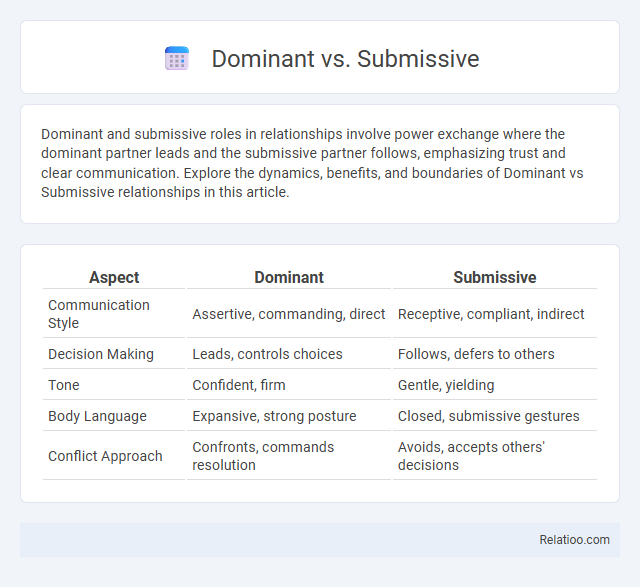Dominant and submissive roles in relationships involve power exchange where the dominant partner leads and the submissive partner follows, emphasizing trust and clear communication. Explore the dynamics, benefits, and boundaries of Dominant vs Submissive relationships in this article.
Table of Comparison
| Aspect | Dominant | Submissive |
|---|---|---|
| Communication Style | Assertive, commanding, direct | Receptive, compliant, indirect |
| Decision Making | Leads, controls choices | Follows, defers to others |
| Tone | Confident, firm | Gentle, yielding |
| Body Language | Expansive, strong posture | Closed, submissive gestures |
| Conflict Approach | Confronts, commands resolution | Avoids, accepts others' decisions |
Understanding Dominant and Submissive Roles
Understanding dominant and submissive roles involves recognizing the distinct responsibilities and behaviors each partner adopts within a power dynamic. The dominant typically takes control, sets boundaries, and guides the interaction, while the submissive consents to and embraces this leadership, finding empowerment in surrender. Your exploration of these roles can enhance communication, trust, and mutual satisfaction in relationships centered around power exchange.
Key Differences: Dominance vs Submissiveness
Dominance involves asserting control, confidence, and leadership within interactions, while submissiveness entails yielding, compliance, and receptiveness to another's direction. Key differences lie in authority distribution: dominant individuals guide decisions and actions, whereas submissive individuals embrace guidance and support. Your understanding of these dynamics helps navigate boundaries, communication, and mutual respect in diverse relationships.
Psychological Foundations of Power Dynamics
Power dynamics in relationships are rooted in complex psychological foundations involving control, trust, and communication. Dominant individuals often exhibit higher assertiveness and a need for influence, while submissive partners display increased responsiveness and trust, facilitating a mutual exchange of power that enhances emotional intimacy. Your understanding of these roles can improve the balance and satisfaction within any dynamic by fostering empathy and clear boundaries.
Common Myths About Dominance and Submission
Common myths about dominance and submission often confuse these roles with abuse or non-consensual behavior, but true D/s dynamics are based on explicit consent, trust, and open communication. Another misconception is that dominance means constant control or aggression, whereas it can involve nurturing, care, and mutual respect. Many also falsely believe submissive individuals lack autonomy, but in healthy D/s relationships, submissives actively choose their role and boundaries.
Consent and Communication in D/s Relationships
Consent and communication form the foundation of healthy D/s relationships, ensuring all parties explicitly agree to power exchange roles. Clear boundaries and continuous dialogue foster trust and mutual respect, preventing misunderstandings or coercion in dominant-submissive dynamics. Establishing safe words and check-ins enhances emotional safety, reinforcing consensual participation in the agreed-upon power structure.
Traits of a Healthy Dominant Partner
A healthy dominant partner exhibits clear communication, emotional intelligence, and unwavering respect for boundaries, ensuring mutual consent and trust within the power dynamic. They prioritize their submissive's well-being, practicing empathy and patience while maintaining responsible control. Consistent transparency, confidence without arrogance, and a commitment to ongoing negotiation distinguish a dominant role that fosters safety, growth, and positive connection.
Traits of a Healthy Submissive Partner
A healthy submissive partner demonstrates clear communication skills, setting boundaries and expressing needs openly to maintain mutual respect. They exhibit trust and emotional intelligence, fostering a safe environment that supports vulnerability and growth within the power dynamic. Commitment to consent and self-awareness ensures their role enhances the relationship's balance without compromising personal autonomy.
Exploring D/s in Romantic Relationships
Exploring D/s in romantic relationships involves understanding the nuanced roles of Dominant and Submissive, where power exchange fosters deep trust and emotional intimacy. Your exploration of these dynamics can enhance communication, boundaries, and mutual satisfaction, creating a unique and consensual connection. Embracing a power dynamic requires ongoing negotiation and respect for each partner's limits and desires.
Setting Boundaries and Safe Words
Setting boundaries and safe words is crucial in Dominant, Submissive, and Power dynamic relationships to ensure consent and mutual respect. Clear communication about limits helps prevent physical and emotional harm, fostering trust and psychological safety. Safe words serve as immediate signals to pause or stop activities, reinforcing control and wellbeing within consensual power exchange contexts.
Personal Growth Through D/s Dynamics
Exploring Dominant vs Submissive roles within power dynamics fosters significant personal growth by enhancing self-awareness and emotional intelligence. Your ability to communicate boundaries and desires clearly cultivates trust and vulnerability, essential for deepening connections. Embracing the responsibilities and freedoms in D/s relationships can transform your confidence and resilience both inside and outside the dynamic.

Infographic: Dominant vs Submissive
 relatioo.com
relatioo.com